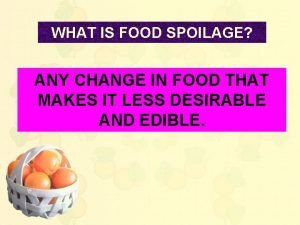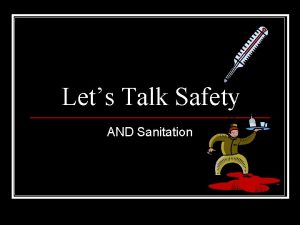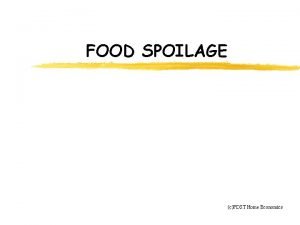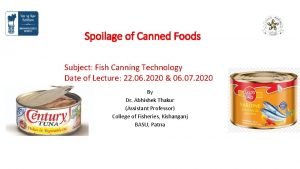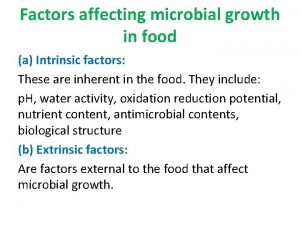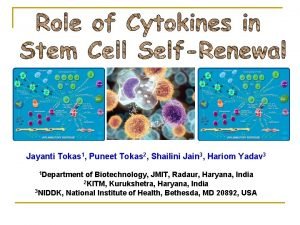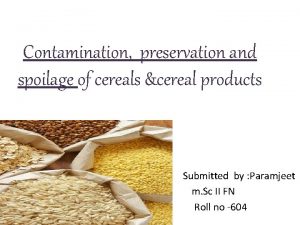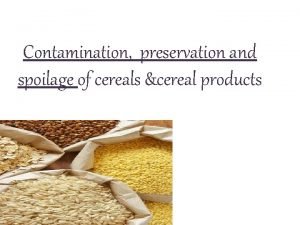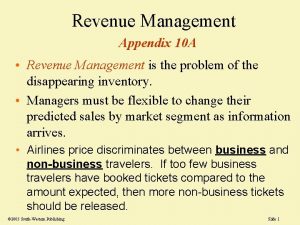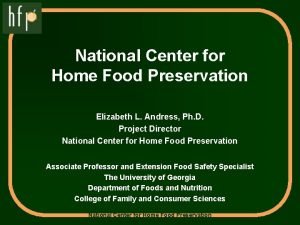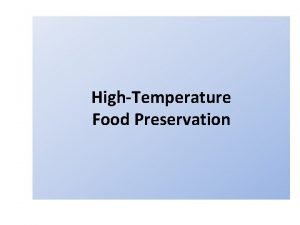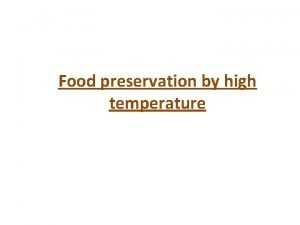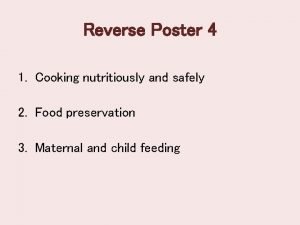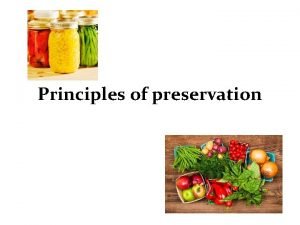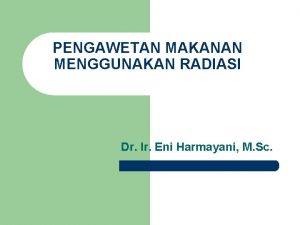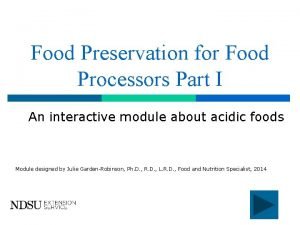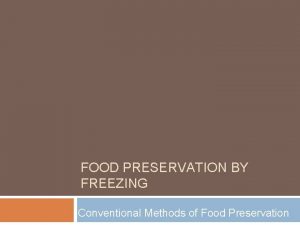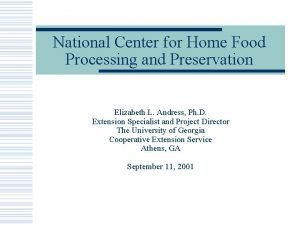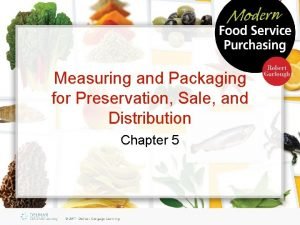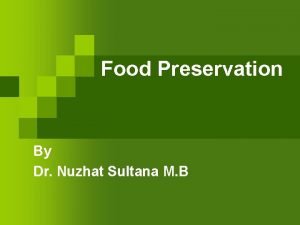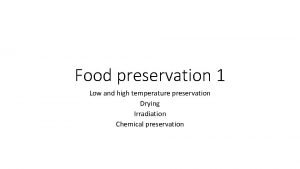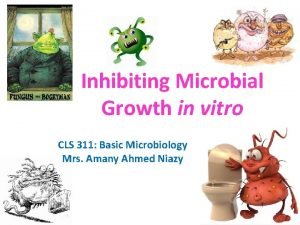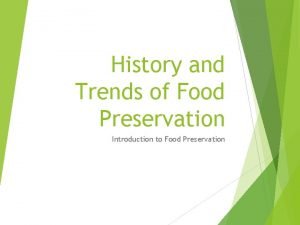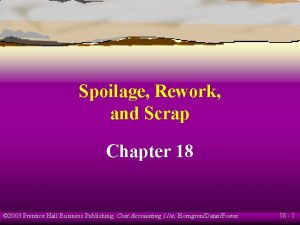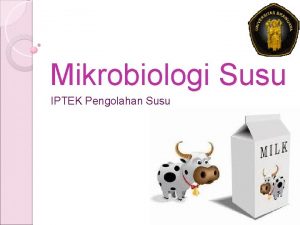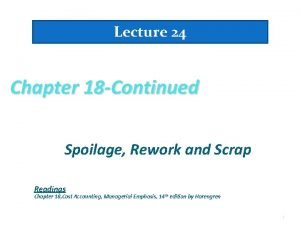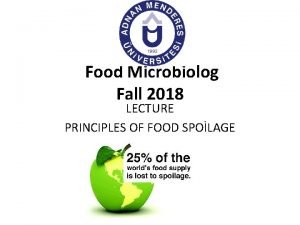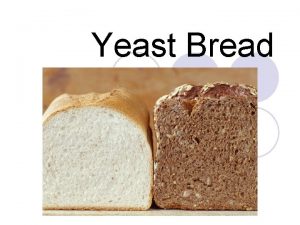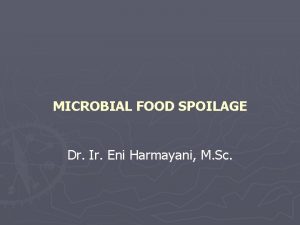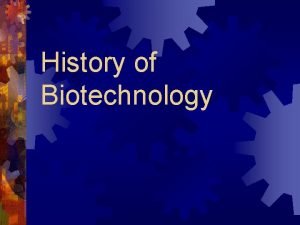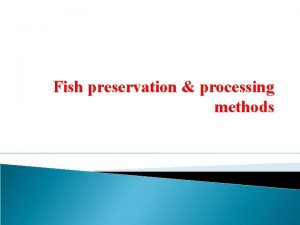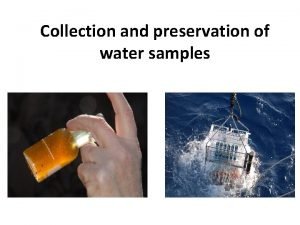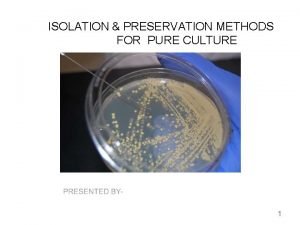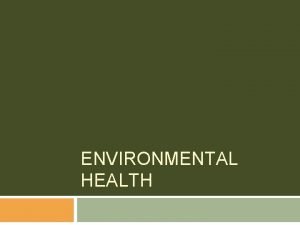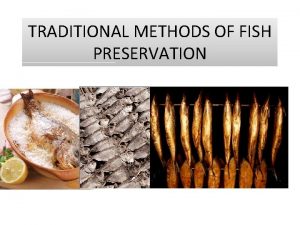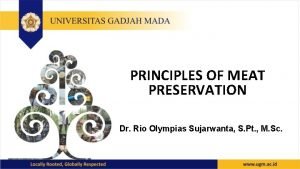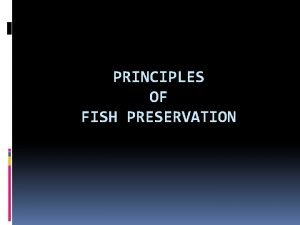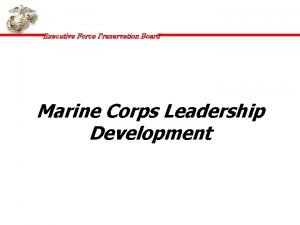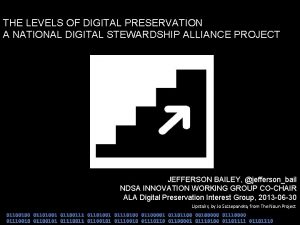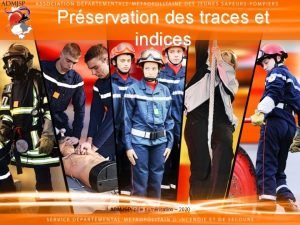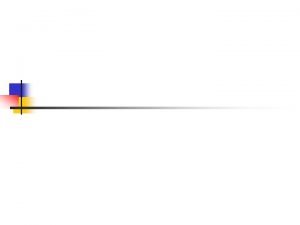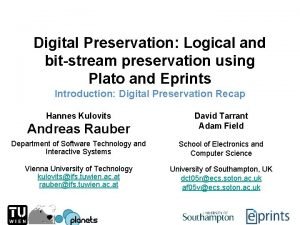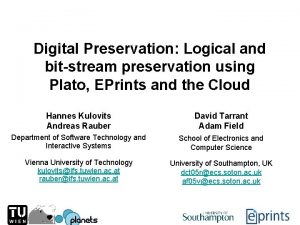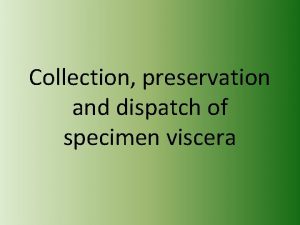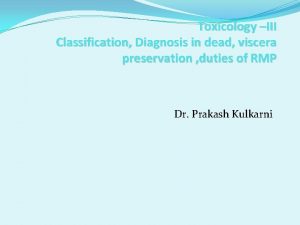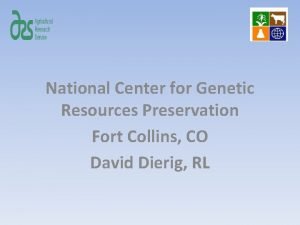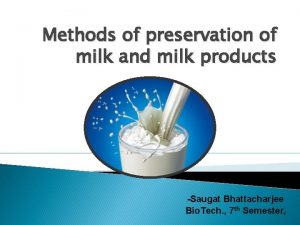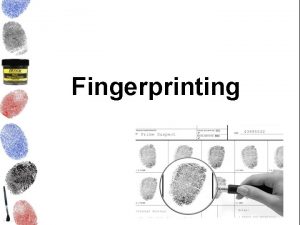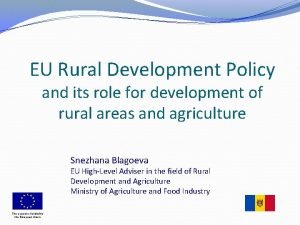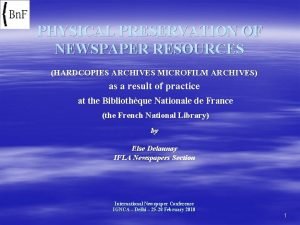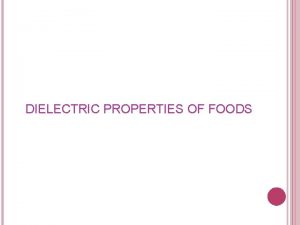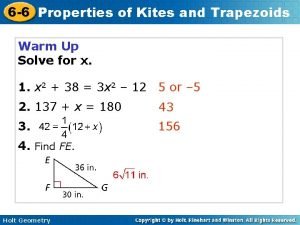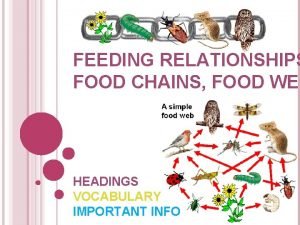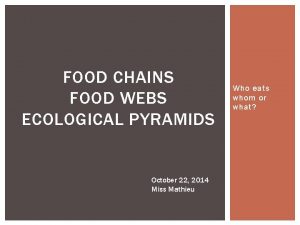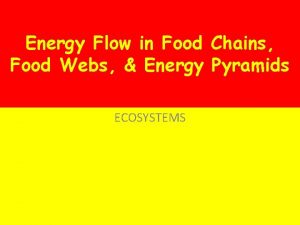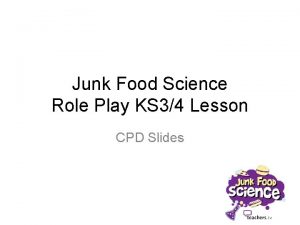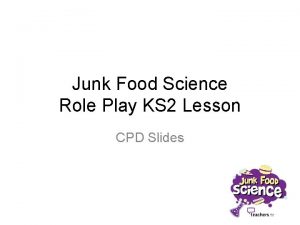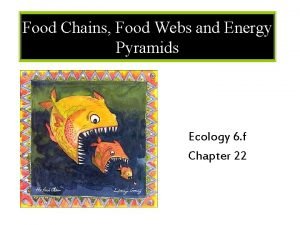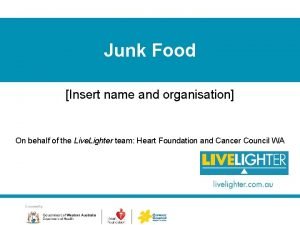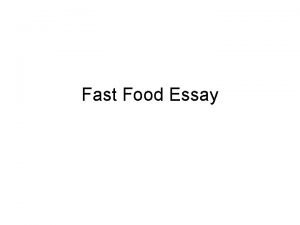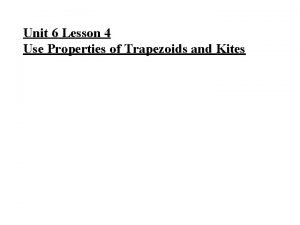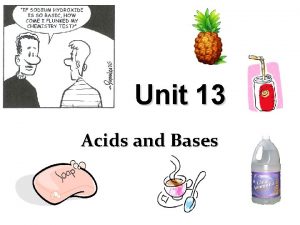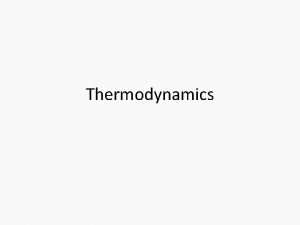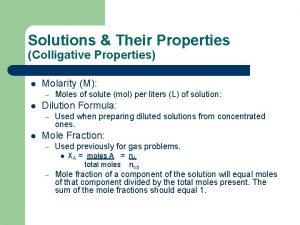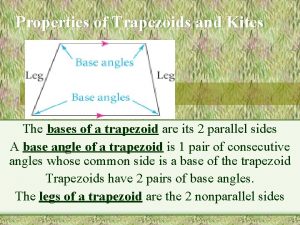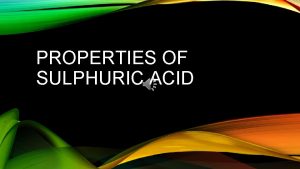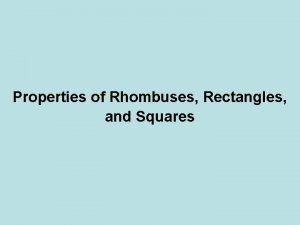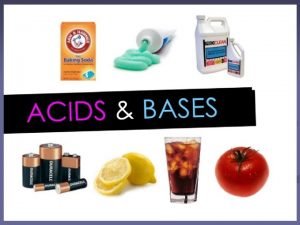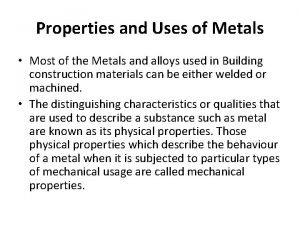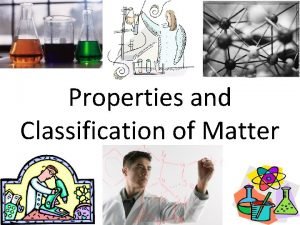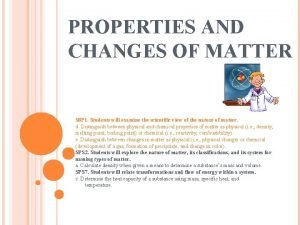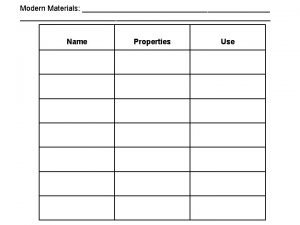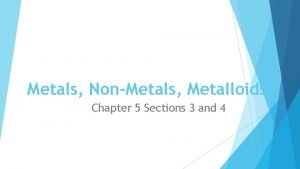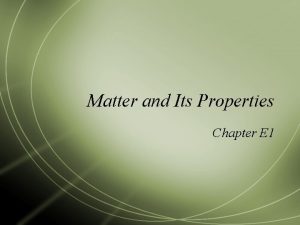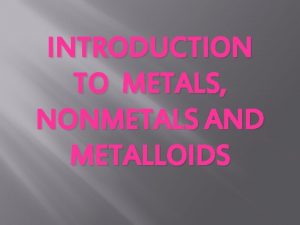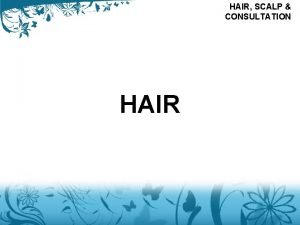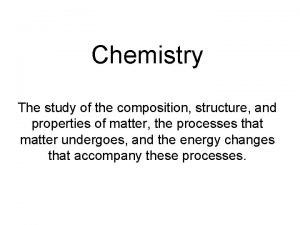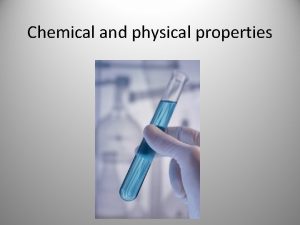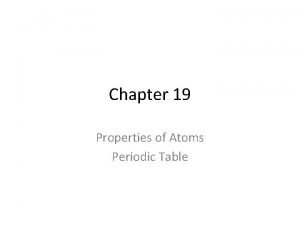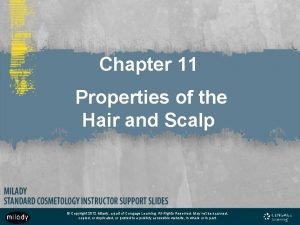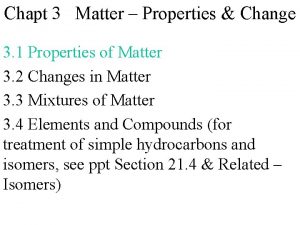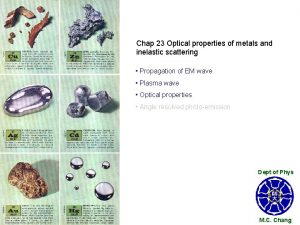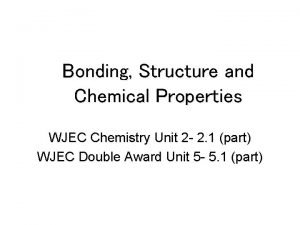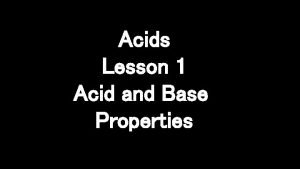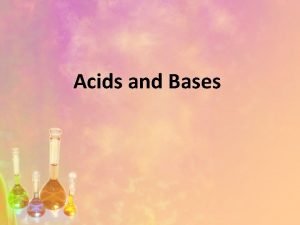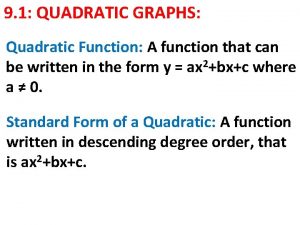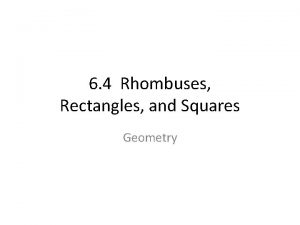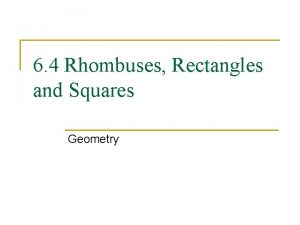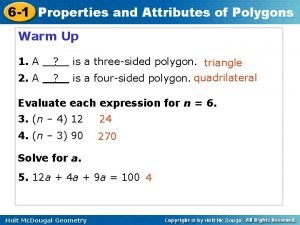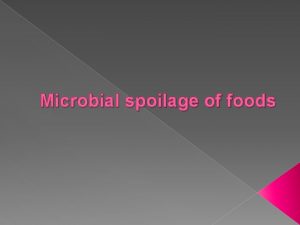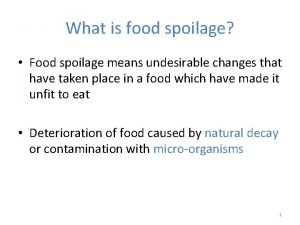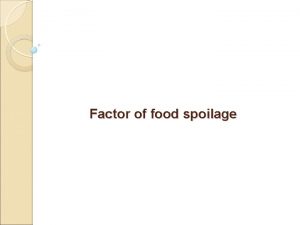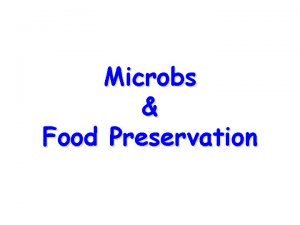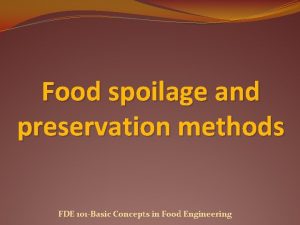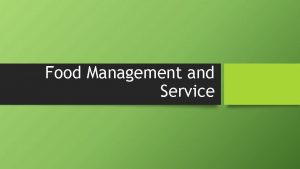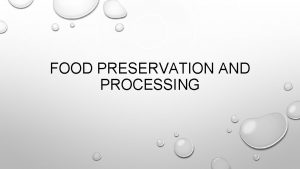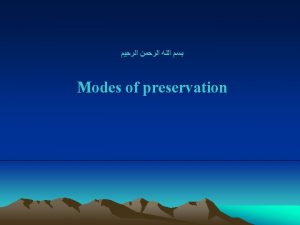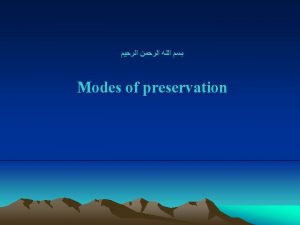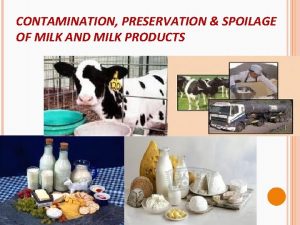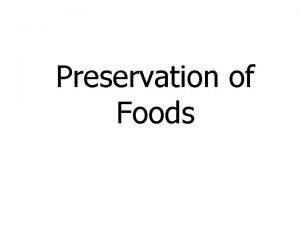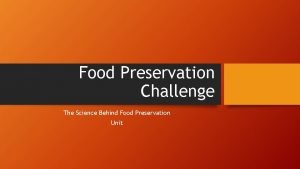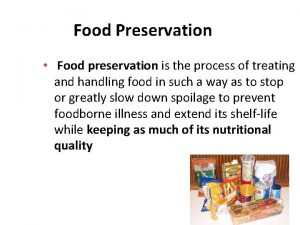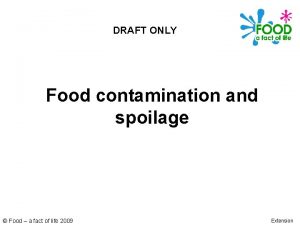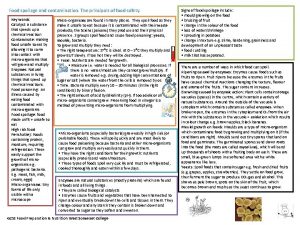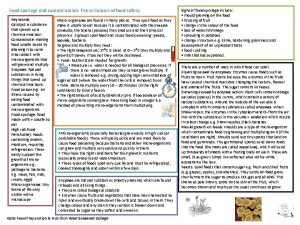Food Properties Food Spoilage and Food Preservation 2


















































































































































- Slides: 146


Food Properties Food Spoilage and Food Preservation 涉及内容:食品特征、食品腐败 和食品保藏 2


1、Introduction (1) Most food is produced 绝大多数的食品是要经过加 处理的 • Once or twice per year at harvests 每年在收获季节,可有一到两次的采收 • Far away from big cities 原料远离城市 4


3、Introduction (3) That is why there is a need for 这就是 为什么对以下两点有需要的原因 • Food preservation food industry 食品的保藏 食品 业生产 • Food transportation food retail 食品的运输 食品的零售 6

4、Introduction (4) Historically, objectives of food technologies have been : 自古以来,食品加 技术的目的在于: Ÿ preservation of food 食品获得良好的保藏性 Ÿ rendering food more palatable and digestible 食品更加美味可口和容易消化吸收 7

5、Introduction (5) In modern times, food technologies are applied with the additional objectives : 在当代,食品加 技术还运用于以下几方面: 1. developing new food products 开发新食品 1. giving food desired functional properties 赋予食品更多的功效 1. improving nutritional and organoleptic quality 提高食品的营养价值和口感 1. ensuring safety 8 保证食品的安全性

6、Introduction (6) Microorganisms in food are 食品中的微生物 • helpful: for fermentation 有益之处:发酵 • competitive: cause spoilage 竞争性:导致食品腐败 • hazardous: cause foodborne disease 危害性:导致食源性疾病 9

Objective 2、学习目标 To understand : 需要了解: Ÿ how different food technologies can be used to prevent spoilage and/or control hazards in foods 防止食品腐败和(或)控制潜在危害的食品加 技术不同 Ÿ the factors (parameters) which influence the process and thus the safety of the final products 影响加 过程以及终产品安全的各种因素(参数) Ÿ how to monitor these factors 如何监控这些因素 10


Classes of food technologies 食品加 技术的类型 Food technologies can be classified into those that : 食品加 技术可归纳成以下三类: Ÿ render food safe 提高食品的安全性; Ÿ control contaminants i. e. prevent growth of microorganisms or production of toxin(s) 控制污染,即防止微生物生长或产生毒素 Ÿ prevent (re-) contamination 预防(二次)污染 12





How temperature affects growth rate of a bacterial population 1、温度对细菌群落生长速率的影响 B (Optimum)最适温度 C (Minimum) 最低温度 A (Maximum) 最高温度 Cold Hot Temperature 温度 17

Growth of S. typhimurium at different temperatures 不同温度下鼠伤寒沙门氏菌的生长 9 8 7 6 5 4 3 2 1 0 25° 20° 15° 10° 0 1 2 3 Time (Days) 天数 18 4 5

Temperature range for growth of pathogens 致病菌生长的温度范围 Temperature°C Salmonella 沙门氏菌 Campylobacter 弯曲杆菌 E. coli 大肠杆菌 S. aureus 金黄色葡萄球菌 C. botulinum (proteolytic) 肉毒梭状芽孢杆菌(蛋白质水解型) C. botulinum (non - proteolytic) 肉毒梭状芽孢杆菌(非蛋白质水解型) B. Cereus 蜡状芽孢杆菌 19 Min. Opt. Max. 5 30 10 6. 5 10 35 - 37 42 37 37 - 40 47 47 48 48 50 3. 3 4 25 – 37 30 - 35 48 - 50

Temperature range for grow of toxigenic moulds 产毒素霉菌生长的温度范围 Temperature °C Min. Opt. Max. Penicillium verrucosum 疣孢青霉 0 20 31 Aspergillus ochraceus 赫曲霉 8 28 37 Aspergillus flavus 10 32 42 3 25 37 黄曲霉 Fusarium moniliforme 串珠镰孢霉 20

Mycotoxins in food 食品中的霉菌毒素 Mould 霉菌 Aspergillus flavus 黄曲霉 Aspergillus parasiticus 寄生曲霉 Fusarium graminearium 镰刀菌 氧瓜蒌镰菌醇 Fusarium moniliforme 串珠镰刀菌 刀菌毒素 Aspergillus ochraceus 赫曲霉 赭曲霉素 Penicillium verrucosum 疣孢青霉 21 Product 产品 Toxin(s) 毒素 cereals, nuts 谷类,坚果 peanuts cereals, aflatoxin 黄曲霉毒素 花生 deoxynivalenon (DON) 谷类 fumonism 谷类 ochratoxin 谷类 coffee 咖啡 脱 串珠镰

Temperature zones 温度范围 Boiling. Point 沸点 Pasteurising. Temperature 巴氏灭菌温度 100° 72° SAFETY 安全温度 60° Body. Temperature 体温 Fridge 冷藏箱 Freezer 冷冻 22 36. 5° 10° 0° DANGER 危险温度 SAFETY 安全温度

Psychro trophic pathogens 嗜冷致病菌 Ø L. monocytogenes 单核细胞增生李斯特菌 Ø Y. enterocolitica 小肠结肠炎耶尔森氏菌 Ø C. botulinum type 肉毒梭状芽孢杆菌 23

Water activity 2、水分活度 Ø Water is required for the growth and metabolism of microorganisms 水是微生物生长和新陈代谢必需的物质 Ø All the water in foods is not available for microorganisms 并非食品中的水分都能被微生物利用 Ø The degree of availability of water is measured by water activity (a w ) 用水分活度a w 衡量有效水分的含量 Ø Chemical and enzymatic reactions are also affected by availability of water 化学反应和酶反应也受有效水分的影响 24

Water activity (definition) 水分活度a w的定义 a w is the ratio of water vapour pressure of food (p) to that of pure water (po) at the same temperature. a w指相同温度下,食品的水蒸汽压P和纯水的蒸 汽压P 0之比。 a w = p/ po 0<aw<1 25

Water activity (3) 水分活度a Reaction rate 反应速率 w Growth of: Moulds 霉菌 Yeasts 酵母 Bacteria 细菌 Lipid oxydation 油脂氧化 Enzymatic activity 酶的活力 Non-enzymatic Browning 非酶褐变 0. 1 26 0. 2 0. 3 0. 4 0. 5 0. 6 0. 7 0. 8 0. 9 Aw

Minimum levels of a. W permitting growth ( at near optimum temperatures ) 微生物生长必需的最低水分活度(在接近最适温度下) Moulds 霉菌 Yeasts 酵母 Bacteria 细菌 27 Aspergillus chevalieri 曲霉 Aspergillus ochraceus 曲霉 Aspergillus flavus 黄曲霉 Penicillium verrucosum 青霉 Fusarium moniliforme 串珠镰孢霉 Saccharomyces rouxii 鲁氏酵母 Saccharomyces cerevisiae 啤酒酵母 Bacillus cereus 蜡状芽孢杆菌 Clostridium botulinum (proteolytic) 肉毒梭状芽孢杆菌(蛋白水解型) Clostridium botulinum (non-proteolytic) 肉毒梭状芽孢杆菌(非蛋白水解型) Escherichia coli 埃希氏大肠杆菌 Salmonella 沙门氏菌 Staphylococcus aureus 葡萄球状杆菌 0. 71 0. 78 0. 80 0. 79 0. 87 0. 62 0. 90 0. 92 0. 93 0. 97 0. 93 0. 95 0. 83

Range of a. W in foods and their microbial flora 食品中a. W的范围及其微生物菌群 aw range > 0. 98 0. 93 - 0. 98 28 Foods Fresh meats 鲜肉 Fresh fish 鲜鱼 Fresh fruits 鲜果 Fresh vegetables新鲜的蔬菜 Canned vegetables in brine 罐装盐水蔬菜 Canned fruit in light syrup (<3. 5 % salt, 26% sugar) 低盐罐装水果(盐<3. 5%,糖<26%) Fermented sausages 发酵香肠 Processed cheese 加 干酪 Bread 面包 Evaporated milk 炼乳 Tomato paste 番茄酱 (10% salt, 50% sugar) (10%盐。50%糖) Microbial flora (C. perfringens, 产气荚膜梭菌 Salmonella) 沙门氏菌 (Pseudomonas) 假单孢菌 (B. cereus, 蜡状杆菌 C. botulinum, 肉毒梭菌 Salmonella 沙门氏菌) lactobacilli, bacilli and Micrococci 乳酸菌, 芽孢杆菌,微球菌

Range of a. W in foodsand their microbial flora aw range’ aw范围 0. 85 -0. 93 0. 6 - 0. 85 < 0. 6 29 Foods Microbial flora 食品 微生物菌群 Dry fermented S. aureus葡萄球菌 sausages干燥发酵香肠 Mycotoxinproducing moulds Raw ham 生火腿 能产生霉菌毒素的霉菌 (17% salt, saturated sucrose) Spoilage yeasts and moulds (盐 17%,饱和蔗糖) 腐败性酵母和霉菌 Dried fruit 干果 Xerophilic fungi喜旱真菌 Flour 面粉 Cereals 谷类 Halophiles 嗜盐生物 Salted fish 咸鱼 Osmophilic yeasts Nuts 坚果 耐高渗透酵母 Confectionery糖果 Honey 蜂蜜 Noodles 面条 Dried egg, milk 干燥鸡蛋,牛奶 No growth but may remain viable 不生长但能残存于其中

Water activity (4) 水分活度 aw can be reduced by : u u u 下述三种方法能减小aw: Removing water (drying) 除去水分(烘干) Decreasing availability of water by crystalization (freezing) 通过结晶(冷冻)减少有效水分 Decreasing availability by binding water with water binding agents e. g. salt, sugar 利用盐、糖这些亲水试剂与水分子的结合减少有效水分 30

Concentration of Na. Cl and glucose at various aw values (at 25°C) 25°C时不同浓度食盐和葡萄糖溶液的aw aw 1. 00 0. 99 0. 98 0. 96 0. 94 0. 92 0. 90 0. 88 0. 86 31 %w/w Na. Cl %w/w Glucose 葡萄糖 0. 00 1. 74 3. 43 6. 57 9. 38 11. 90 14. 18 16. 28 18. 18 0. 00 8. 90 15. 74 28. 51 37. 83 43. 72 48. 54 53. 05 58. 45

p. H values limiting the growth of pathogens 3、p. H抑制致病菌的生长 p. H Min Escherichia coli 大肠杆菌 4. 4 Salmonella typhi 沙门氏菌 4 - 4. 5 Bacillus cereus 蜡状芽孢杆状菌 4. 9 Clostridium botulinum 4. 6 肉毒梭状杆菌 Staphylococcus aureus 4 金黄色葡萄状球菌 Saccharomyces cerevisiae啤酒酵母2. 3 Aspergillus flavus 曲霉菌 2. 0 Fusarium moniliforme 镰刀菌 2. 5 Penicillium verrucosum 青霉菌 2. 0 32 Max. 8. 5 8 - 9. 6 9. 3 8. 5 9. 8 8. 6 11. 2 10. 7 10. 0

p. H and other factors p. H和其它因素 Microorganisms can grow in lab media at a wider range of p. H than would occur in Foods 与在食品中相比,微生物在实验室培养基中能在更宽的p. H范围内生长 Here, other factors come into effect e. g. microbial competition: (这里,还存在其它因素的影响,如:微生物的竞争) u u 33 oxygen tension 氧气的压力 storage temperature 贮藏温度 reduced aw 降低aw heat damage to cells during processing 加 过程中的热杀菌

p. H Acidification 酸化 Ø addition of vinegar 添加醋 Fermentation 发酵 Ø organic acid 有机酸 Ø competitive exclusion 排除竞争性 Ø antimicrobial agents 抗菌剂 34

p. H of different foods 不同食品的p. H Approximate p. H ranges of some common food commodities 常见食品的p. H范围 p. H 14 13 12 11 10 9 8 7 6 5 4 3 2 35 Fermented shark发酵鲨鱼 Egg white蛋白 Fish Meat 鱼类 肉类 Citrus fruits柑桔 Milk 牛奶 Soft drinks软饮料 Flour面粉 Vegetables 蔬菜 Beer 啤酒

Food technologies that may kill certain microbes 可以杀死某些微生物的食品加 技术 Ø Heat treatments 加热处理 Ø Irradiation 辐射 Ø Disinfection 消毒 Ø Freezing (parasites only) 冷冻(仅对寄生虫有效) Ø High pressure technology 高压技术 36

二、加热处理 加热方法的分类 Method of heating 加热方 法 Cooking 37 烹调 baking / roasting 烘烤 Boiling 煮沸 Frying 油炸 Grilling 烧烤 Microwave 微波加热 pasteurization 巴氏杀菌 Sterilization 杀菌 Heating medium加热介质 Water 水 Air 空气 Water 水 oil 油 Air 空气 electromagnetic radiation 电磁辐射 heat exchanger / water 热交换器(水作为介质) steam under pressure 高压蒸汽

D value D值 Heat resistance is measured by the decimal reduction time D 耐热性是用指数递减时间(D值)来测定的 No: Initial number of microorganisms log N/No 微生物的原始菌数 0 -1 -2 -3 N: Number of microorganism at time t T (℃) 经t时间热处理后微生物的残存菌数 t = D. log No/N D t 38

Heat resistance (1) D. values (min) Vegetative organism 活微生物 Escherichia coli 大肠杆菌 Salmonella spp 沙门氏菌属 耐热性 55℃ 4 60℃ 0. 02 -0. 25 Salmonella typhimurium 鼠伤寒沙门氏菌 0. 056 Salmonella senftenberg 桑夫顿堡沙门氏菌 0. 8 -1. 0 Staphylococcus aureus 葡萄球菌 Listeria monocytogenes 李斯特单胞菌 Campylobacter jejuni 弯曲杆菌 39 1. 1 65℃ 0. 1 5. 0 -8. 3 0. 2 -2. 0

Heat resistance (2) D values (min) Bacterial endospores 细菌芽孢 C. botulinum type A and B 100℃ 110℃ 50 121℃ 0. 1 -0. 2 肉毒梭状芽孢菌 A 型和B型 40 C. botulinum type E 肉毒梭状芽孢菌 E型 C. perfringens 产气夹膜梭状芽孢菌 C. sporogenes 生孢芽孢梭菌 Bacillus cereus 蜡状芽孢杆菌 < 1 sec 0. 3 -20 0. 1 -1. 5 5

Heat resistance (3) Heat resistance ( D-value ) is influenced by many factors, e. g. 耐热性(D值)受许多因素的影响,例如: u u u type or strain of microorganism 微生物的类型或种类 physico - chemical parameters of the medium e. g. water activity, p. H, composition 培养基的物理-化学参数,比如:水分活度、酸碱度以及组 成成分等 age of the cells or state of growth 细胞的年龄或其生长的状态 41

Heat resistance (4) Medium 培养基 Heart infusion broth (p. H = 7. 4; aw = 0. 99) 6. 1 Heart infusion broth+ Na. Cl (p. H = 7. 4; aw = 0. 90) 2. 7 Heart infusion broth+ Sucrose (p. H = 7. 4; aw = 0. 90) 42 D 60 - value Salmonella senftenberg 沙门氏菌 75. 2

Heat treatment 热处理 T Holding temp. 杀菌温度 Minimal lethal temp. 最低热致死温度 t Start of heating effect 热处理开始时间 43 Holding time End of heating effect 恒温时间 热处理结束时间

Effects on proteins and vitamins 对蛋白质和维生素的影响 D 121 (min) Protein degradation 蛋白质降解 Non - enzymatic browning 非酶促褐变 Lipase Thiamin 脂肪 硫胺(维生素 B 1) Vitamin C 44 5 0. 4 - 40 1. 2 - 1. 7 38 - 380 245 维生素C

Pasteurization schemes 1、巴氏杀菌法 Low temperature: 63℃ for 30 min 低温巴氏杀菌: 63℃ ,保持30分钟 High temperature: 72℃ for 15 sec 高温巴氏杀菌: 72℃ ,保持15秒 Ultra-high temperature: 135℃ for 1 sec 超高温巴氏杀菌: 135℃ ,保持1 秒 45

Temperature gradient in hamburger 汉堡包中温度梯度变化图 46

Microwave treatmen 2、微波处理 Heat is generated by friction of water molecules under the influence of electromagnetic waves (500 MHz to 10 GHz) 在电磁波的作用下,水分子相互摩擦产生热量 Rapid but non - uniform heating (cold and hot spots) 加热速度快,但不均匀(存在冷点和热点) 47

Freezing 三、冷冻处理 48

作用: Effective against parasites :对寄生虫的影响 Critical limit : - 18℃ for minimum 24 to 48 h 临界限:- 18 ℃ ,至少要保持24 ~ 48 h,才能杀死寄生虫 No or minimal effect on: 下列情况下,冷冻处理的影响很小或是根本没有 • survival of Bacteria and viruses 残存的细菌和病毒 • enzymatic activity (polyphenol oxidase, lipase) 酶的活性(比如:多酚氧化酶和脂肪酶) 49

irradiation 四、辐射 50

Food irradiation (1) 1、食品辐射保藏 Gamma rays γ射线 produced during decay of radioactive isotopes Cobalt 60, Cesium 137 Good penetration power 钴 60和铯 137放射性同位数衰变时所产生的能量称为γ射线,该 射线是波长非常短的电磁波束,能量较高,穿透物质的能力 很强。 High energy electron beams 高能量电子束 produced by accelerators ,low penetration 由加速器产生,穿透物质的能力较低 X rays X射线 highest penetration power 穿透物质的能力较高 51

Low - dose irradiation 低剂量辐射处理 Low – dose 低剂量 (up to 1 k. Gy) Inhibition of sprouting I 抑制发芽 Insect disinfestation and parasite disinfection Dose (k. Gy) 剂量 延迟生理过程 (比如:过熟) 52 被辐射的产品 0. 05 - 0. 15 Potatoes, onions, garlic, etc. 0. 15 - 0. 5 Cereals and pulses, fresh and dried fruits, dried fish and meat, fresh pork 杀死昆虫和寄生虫 Delay of physiological processes (e. g. ripening) Products irradiated 西红柿、洋葱、大蒜等 谷物、鲜果、干果以及 干鱼、肉和新鲜猪肉 0. 5 - 1. 0 Fresh fruits and vegetables 新鲜水果和蔬菜

Medium - dose irradiation 中等剂量辐射处理 Medium-dose 1 -10 k. Gy 中等剂量 Dose (k. Gy) 剂量 Extension of shelf-life 延长货价寿命 1. 0 - 3. 0 Elimination of spoilage microorganisms and pathogenic消除腐败微 生物和致病菌 Improving technological properties of food 提高食品的品质 53 1. 0 - 7. 0 2. 0 - 7. 0 Products irradiated 辐射的产品 Fresh fish, strawberries, etc. 鲜鱼和草莓等 Fresh and frozen seafood, raw or frozen poultry and meat, etc. 新鲜的和冷冻的海产品以 及冷冻的家禽和肉等 Grapes (increasing juice yield), dehydrated vegetables (reduced cooking time), etc. 葡萄(提高出汁率)和脱水 蔬菜(减少烹调时间)等

High - dose irradiation 高剂量辐射处理 High-dose (10 -50 k. Gy) 高剂量辐射 Sometimes industrial sterilization (in combination with mild heat treatment) 有时应用于 业化杀菌 (与轻微加热处理方法结合) Decontamination of certain food additives and ingredients 消除某些食品添加剂和 成分 的污染 54 Dose (k. Gy) 剂量 30 - 50 10 - 50 Products irradiated 被辐射的产品 Meat, poultry, seafood, prepared foods, sterilised hospital diets 肉、家禽、海产食品和制备 食品、经过杀菌的医院食品 Spices, enzyme preparations 调味品和酶的制备

Sensitivity of microorganisms 微生物的敏感性 Necessary dose 最低剂量 Parasites 1. 0 k. Gy 寄生虫 Bacteria 1 -7 k. Gy 细菌 Viruses > 30 k. Gy 病毒 Parasites 寄生虫 G – Bacteria 革兰氏阴性细菌 G + Bacteria, moulds 革兰氏阳性细菌,霉 +菌 Spores, yeasts孢子和酵母 Viruses 55 病毒

Food irradiation (2) 食品辐射处理 Food irradiation at any dose has been assessed by IAEA, FAO and WHO as safe 国际原子能组织、国际粮农组织以及 世界卫生组织对各种剂量处理的辐射食品进行了评估,认为它具 有安全性 Macronutrients and essential minerals are not affected by food irradiation食品辐射处理不影响其中存在的常量营养元素 和必需矿物质 Certain vitamins e. g. thiamine and tocopherols are sensitive, but the loss is small (10 - 20 % or less) and comparable to thermal processing or drying 某些维生素,如维生素B 1和维 生素E,对辐射敏感。但是,与加热和干燥法相比,其损失量很 小( 10~20 % 或者更少) 56


58
















74











































UV – radiation 2、紫外辐射 Produced by mercury lamps Limited penetration Useful for destroying microorganism in air, surfaces and in thin liquid films Most effective against vegetative bacteria >yeast > bacterial spores > mould spores 水银灯产生的紫外线具有一定的穿透能力,可有效杀死空气 中、物品表面和液体薄膜上的微生物。 紫外辐射对活体组织的作用效果如下: 细菌>酵母>细菌芽孢>霉菌孢子 117

Chemical disinfection 五、化学消毒 118

消毒剂 Example of application 需要消毒的对象 Water 水 Fruits and vegetables 水果和蔬菜 Surfaces and equipment 物质表面和设备 119 Example of disinfectant agent 消毒剂 chlorine 氯 hypochlorite 次氯酸盐 dioxide 二氧化氯 iodine chloramines ozone 碘酒 氯胺 臭氧

Disinfection of water 1、水的消毒 Efficacy of different disinfectants on pathogens is measured by the C. t value required to achieve 99 % reduction or inactivation of microorganisms 利用C. t值评价各种消毒剂杀灭致病菌的功效。 C. t值指杀死或钝化 99%微生物。 120

Chlorination of water (1) 氯化水处理 Organism 微生物 C. t value (mg. min/l ) for 99% inactivation by chlorine at 5 ℃ and p. H 6 -7 在 5℃ 和p. H 6~7下,氯化水钝化 99%微 生物的 C. t 值(mg. min/l ) E. coli 大肠杆菌 0. 034 - 0. 05 Hepatitis A virus 肝炎A病菌 1. 8 Poliovirus type 1 1. 1 - 2. 5 脊髓灰质炎病毒(类型1) Rotavirus 轮状病毒 0. 01 - 0. 05 G. lamblia cyst 47 - 150 C. parvum 小棒杆菌 7200 121

Chlorination of water (2) (2)氯化水处理 Efficacity depends on purity : 消毒效率取决于纯度: Median 半混浊度 : < 1 NTU Maximum in single simple: 5 NTU 在纯样品中的最大浊度: 5 NTU 122

Chlorination of water (3) (3)水的消毒 The normal conditions for chlorination : 氯化处理的标准条件: 1)free resid. Chlorine ≥ 0. 5 mg / l 残留的游离氯气含量 2)contact time minimum 30 minutes 最低接触时间为 30分钟 3)p. H <8 4)water turbidity < 1 NTU 水的浑浊度 123

Chlorination of water (4) (4)水的消毒 To eliminate parasites and decrease turbidity, chlorination is combined with : 为了消灭寄生虫,减少浑浊度,可将氯化处理 与下述方法结合使用: u u 124 coagulation and flocculation 凝固和絮凝 filtration 过滤

Disinfection of fruits and vegetables (5)水果和蔬菜的消毒处理 Depending on type of fruits and vegetables some decrease may be obtained Not fully effective 根据水果和蔬菜的类型,能有一定的消毒作 用,但并不能达到圆满的效果 125

High pressure technology 六、高压技术 126

Ø Hydrostatic pressure 1000 Mpa 流体静压 Ø Destruction of bacteria and fungi (90 % by 400 MPa for 5 min) 在 400 Mpa 下处理5分钟能杀死 90%的细菌和真菌 Ø Resistance depends on p. H and T 抵抗力取决p. H 和T Ø Acts uniformly and instantaneously 作用力均匀、瞬时 Ø Spores are resistant and tolerate pressure up to 1200 Mpa 芽孢能够抵抗和忍受的压力高达 1200 Mpa 127










Vacuum packaging 七、真空包装 Vacuum packaging 真空包装 Applied for fresh meat in combination with refrigeration 结合冷藏方法用于鲜肉保藏 137

Antimicrobial agents 八、抗菌剂 Ø Curing salts e. g nitrites 食品加 用盐,如:亚硝酸盐 Ø Bacteriocins e. g. Nisin 细菌素,如:尼生素 Ø Gas: e. g CO 2 气体,如: CO 2 Ø Organic acids / salts e. g benzoic, sorbic and propionic acid 有机酸或盐,如:安息香酸,山梨酸和丙酸 138

Modified atmosphere packaging(MAP) 九、气调包装 20% to 40% carbon dioxide: 20%~ 40% 二氧化碳含量 80% to 60% nitrogen: 80%~60% 氮气的含量 combined with cold storage 与冷藏相结合 139

Smoking 十、烟熏 Combination of several factors : 几个因素的共同作用 u u u 140 heat treatment 热处理 drying 干燥 antimicrobial agent in the smoke 烟雾中的抗菌剂





Combinations of food technologies 十三、食品 艺的组合 Combined technologies 组合 艺 u Milk pasteurization and aseptic packaging 牛奶的巴氏杀毒和无菌包装 u Hurdle technologies 栅栏技术 Ø fermentation, smoking 发酵,烟熏 Ø Refrigerated processed food of extended durability (REPFED) 冷藏加 食品的长期保存 145

THE END! 146
 Define food spoilage
Define food spoilage Food spoilage signs
Food spoilage signs Spoilage of food
Spoilage of food What are the causes of food spoilage
What are the causes of food spoilage Spoilage of canned foods
Spoilage of canned foods Factors affecting food spoilage
Factors affecting food spoilage Food spoilage
Food spoilage Chalky bread
Chalky bread Preservation of cereals and cereal products
Preservation of cereals and cereal products Spillage and spoilage
Spillage and spoilage Abnormal spoilage example
Abnormal spoilage example Spoilage rework and scrap
Spoilage rework and scrap National food preservation
National food preservation Preservation by high temperature
Preservation by high temperature 12-d concept
12-d concept Food preservation poster
Food preservation poster Preservation by heating
Preservation by heating Eni harmayani
Eni harmayani Food preservation definition
Food preservation definition Methods of food freezing
Methods of food freezing Burying meat in the ground
Burying meat in the ground National center for home preservation
National center for home preservation Advantages of food preservation
Advantages of food preservation Nuzhat sultana
Nuzhat sultana Food preservation by high temperature
Food preservation by high temperature Physical methods of food preservation
Physical methods of food preservation Advantages of hurdle technology
Advantages of hurdle technology Food preservation history
Food preservation history Spoilage accounting journal entry
Spoilage accounting journal entry Spoilage mikroorganisme
Spoilage mikroorganisme Costs of normal spoilage are usually accounted for as
Costs of normal spoilage are usually accounted for as Room spoilage front office
Room spoilage front office Microbial spoilage of egg
Microbial spoilage of egg Classification of yeast bread
Classification of yeast bread Harmayani
Harmayani Wine spoilage organisms
Wine spoilage organisms Extensive and intensive properties
Extensive and intensive properties Physical property and chemical property
Physical property and chemical property Fish preservation and processing
Fish preservation and processing Samples of
Samples of Apush conservation vs preservation
Apush conservation vs preservation Culture pure
Culture pure Careful protection and preservation of environment
Careful protection and preservation of environment Fpc marine corps
Fpc marine corps Traditional methods of fish preservation
Traditional methods of fish preservation Preservation of quran
Preservation of quran Principles of meat preservation
Principles of meat preservation What are the principles of fish preservation
What are the principles of fish preservation Fossil preservation types
Fossil preservation types Usmc force preservation council
Usmc force preservation council Illinois digital preservation
Illinois digital preservation Ndsa levels of preservation
Ndsa levels of preservation Préservation des traces et indices
Préservation des traces et indices Plenary inspiration
Plenary inspiration Bitstream preservation
Bitstream preservation Bitstream preservation
Bitstream preservation Viscera preservation
Viscera preservation Ana language preservation grant
Ana language preservation grant Preservation of viscera
Preservation of viscera National center for genetic resources preservation
National center for genetic resources preservation Pasteurization defination
Pasteurization defination The study of fingerprints for identification purposes
The study of fingerprints for identification purposes Keratititis
Keratititis Soil preservation
Soil preservation Justian code
Justian code What is preservation
What is preservation Floryzacja
Floryzacja Pawnee seed preservation project
Pawnee seed preservation project National historic preservation act
National historic preservation act Conservation vs preservation
Conservation vs preservation Michigan historic preservation network
Michigan historic preservation network Software preservation network
Software preservation network Utah historic preservation tax credit
Utah historic preservation tax credit Oakland affordable housing preservation initiatives
Oakland affordable housing preservation initiatives Microfilm preservation
Microfilm preservation Historic tax credits 101
Historic tax credits 101 Alaska historic preservation act
Alaska historic preservation act Unit 2 food food food
Unit 2 food food food Food chain food chain food chain
Food chain food chain food chain Disupear
Disupear Properties of food
Properties of food Properties of kites
Properties of kites Primary consumers
Primary consumers Food chain of producers and consumers
Food chain of producers and consumers How does the food chain go
How does the food chain go Levels of nourishment in a food chain
Levels of nourishment in a food chain Difference between food webs and food chains
Difference between food webs and food chains Food chains, food webs and ecological pyramids
Food chains, food webs and ecological pyramids Food chain and food web examples
Food chain and food web examples Why does organism eat another organism
Why does organism eat another organism Chaparral food chain
Chaparral food chain Role play on healthy food and junk food
Role play on healthy food and junk food Of junk food
Of junk food Food web of the desert
Food web of the desert Junk food names
Junk food names Fast food introduction essay
Fast food introduction essay Chapter 5 properties and attributes of triangles
Chapter 5 properties and attributes of triangles Angles in a kite
Angles in a kite Properties of acid
Properties of acid Atomic structure and properties ap chemistry
Atomic structure and properties ap chemistry Intensive and extensive properties thermodynamics
Intensive and extensive properties thermodynamics Terylene fiber
Terylene fiber Elemental analysis of an unknown pure substance
Elemental analysis of an unknown pure substance Solids liquids and gases section 2 properties of fluids
Solids liquids and gases section 2 properties of fluids Molecules of solid liquid and gas
Molecules of solid liquid and gas Use properties of rational and irrational numbers
Use properties of rational and irrational numbers Properties of trapezoids and kites
Properties of trapezoids and kites Chemical properties of sulphuric acid
Chemical properties of sulphuric acid Conditions for rhombuses rectangles and squares practice
Conditions for rhombuses rectangles and squares practice Properties of addition and multiplication
Properties of addition and multiplication Amphoteric vs amphiprotic
Amphoteric vs amphiprotic Uses of pig iron
Uses of pig iron Classification and properties of matter
Classification and properties of matter Properties and changes of matter worksheet
Properties and changes of matter worksheet A scientist performs an experiment, and an actor performs a
A scientist performs an experiment, and an actor performs a Thermal properties of dental materials
Thermal properties of dental materials Examples of physical changes
Examples of physical changes Multiplication and division properties
Multiplication and division properties Properties of modern materials
Properties of modern materials The physical properties of metals include luster and
The physical properties of metals include luster and Non metals melting and boiling points
Non metals melting and boiling points Properties of solid
Properties of solid Matter and its properties
Matter and its properties Associative commutative identity
Associative commutative identity Math properties identity
Math properties identity Material properties and definitions
Material properties and definitions The properties and interactions of magnets are called
The properties and interactions of magnets are called Properties of metals nonmetals and semimetals
Properties of metals nonmetals and semimetals Characteristics of system in system analysis and design
Characteristics of system in system analysis and design Chapter 11 properties of the hair and scalp answers
Chapter 11 properties of the hair and scalp answers Associative property vs commutative property
Associative property vs commutative property Study of composition structure and properties
Study of composition structure and properties Chemical and physical properties of helium
Chemical and physical properties of helium Properties of atoms and the periodic table
Properties of atoms and the periodic table The two rows of elements that seem to be disconnected
The two rows of elements that seem to be disconnected Properties of hair and scalp
Properties of hair and scalp Limits and their properties
Limits and their properties Matter-properties and changes answer key
Matter-properties and changes answer key Optical properties of metals and nonmetals
Optical properties of metals and nonmetals Density measures an object's brainpop
Density measures an object's brainpop Wjec periodic table
Wjec periodic table Properties of acids and bases chart
Properties of acids and bases chart Acids vs bases
Acids vs bases 9-1 quadratic graphs and their properties
9-1 quadratic graphs and their properties 6-4 properties of rhombuses rectangles and squares
6-4 properties of rhombuses rectangles and squares 6-4 properties of rhombuses rectangles and squares
6-4 properties of rhombuses rectangles and squares Attributes of polygons
Attributes of polygons
